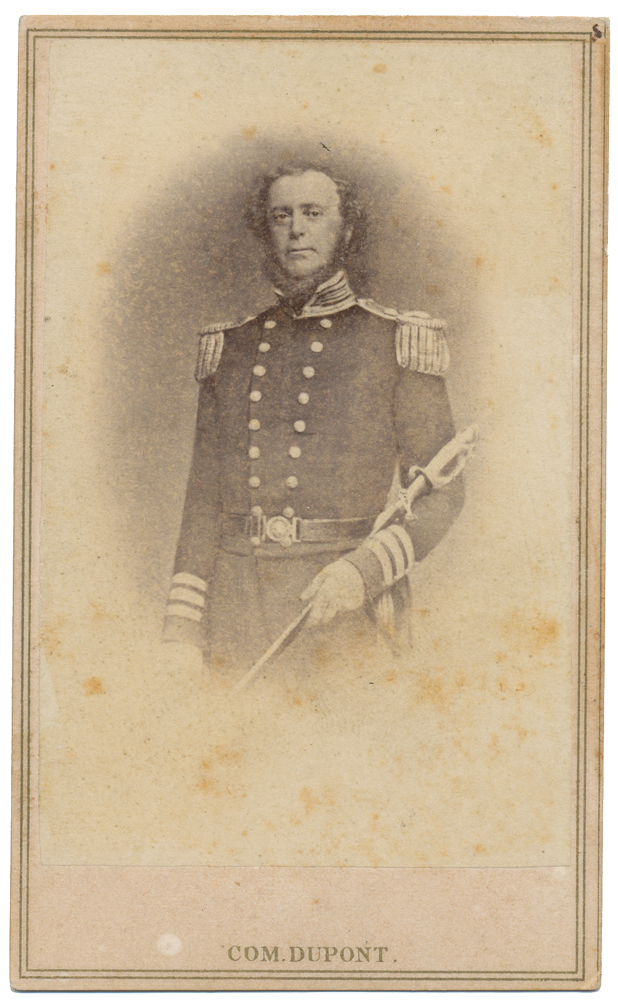site search
online catalog
CDV OF U.S. REAR ADMIRAL SAMUEL F. DU PONT

Hover to zoom


$100.00 SOLD
Quantity Available: None
Item Code: 1139-168
Three-quarter view of Du pont in dress uniform. He wears a double-breasted coat with dress epaulettes, and sword belt. He cradles his sword in his arm. Image is clear with good contrast; some surface dirt and foxing. A printed identification is under the photo on front of the mount. Photographer’s backmark, E. Anthony, New York, from a Brady negative.
Samuel Francis Du Pont (September 27, 1803 – June 23, 1865) was a rear admiral in the United States Navy, and a member of the prominent Du Pont family. In the Mexican–American War, Du Pont captured San Diego, and was made commander of the California naval blockade. Through the 1850s, he promoted engineering studies at the United States Naval Academy, to enable more mobile and aggressive operations. In the American Civil War, he played a major role in making the Union blockade effective, but was controversially blamed for the failed attack on Charleston, South Carolina in April 1863.
When communication was cut off with Washington at the start of the Civil War, Du Pont took the initiative of sending a fleet to the Chesapeake Bay to protect the landing of Union troops at Annapolis, Maryland. In June 1861 he was made president of a board in Washington formed to develop a plan of naval operations against the Confederacy. He was appointed flag officer serving aboard the steam frigate Wabash as commander of the South Atlantic Blockading Squadron, leading from Norfolk, Virginia, the largest fleet ever commanded by an American officer at that time. On November 7, Du Pont led a successful attack on the fortifications at Port Royal harbor in South Carolina. This victory enabled Union naval forces to secure the southern waters of Georgia and the entire eastern coast of Florida, and an effective blockade was established. On January 3, 1862, he was promoted to the newly created rank of Flag Officer (equivalent to the rank of Commodore, which would be created in July 1862). Du Pont received commendations from U.S. Congress for his brilliant tactical success, and was appointed rear admiral on July 16, 1862.
Towards the end of 1862, Du Pont became the first U.S. naval officer to be assigned command over armored "ironclad" ships. Though he commanded them ably in engagements with other ships, they performed poorly in an attack on Fort McAllister, due to their small number of guns and slow rate of fire. Du Pont was then given direct orders from the Navy Department to launch an attack on Charleston, South Carolina which was the site of the first shots fired in the Civil War with the fall of Fort Sumter and the main area in which the Union blockade had been unsuccessful. Though Du Pont believed that Charleston could not be taken without significant land troop support, he nevertheless attacked with nine ironclads on April 7, 1863. Unable to navigate properly in the obstructed channels leading to the harbor, his ships were caught in a blistering crossfire, and he withdrew them before nightfall. Five of his nine ironclads were disabled in the failed attack, and one more subsequently sank. The Secretary of the Navy, Gideon Welles, blamed Du Pont for the highly publicized failure at Charleston. Du Pont himself anguished over it and, despite an engagement in which vessels under his command defeated and captured a Confederate ironclad, was relieved of command on July 5, 1863, at his own request and was replaced in this Office by Rear Admiral John A. Dahlgren.
This image was part of the Ray Ritchie collection. [jet] [ph:L]
~~~~~~~~~~~~~~~~~~~~~~~~~~~~~~~~~~~
THIS ITEM, AS WITH ALL OTHER ITEMS AVAILABLE ON OUR WEB SITE,
MAY BE PURCHASED THROUGH OUR LAYAWAY PROGRAM.
CLICK HERE FOR OUR POLICIES AND TERMS.
THANK YOU!
Inquire About CDV OF U.S. REAR ADMIRAL SAMUEL F. DU PONT
Most Popular
Historical Firearms Stolen From The National Civil War Museum In Harrisburg, Pa »
Theft From Gravesite Of Gen. John Reynolds »
Selection Of Unframed Prints By Don Troiani »
Fine Condition Brass Infantry Bugle Insignia »
Large English Bowie Knife With Sheath 1870’S – 1880’S »
Imported (Clauberg) Us Model 1860 Light Cavalry Officer's Saber »
featured item
VERY SCARCE 1799-1800 SWAN CONTRACT VIRGINIA MILITIA REGIMENTALLY MARKED MUSKET: 42nd REGIMENT, PITTSYLVANIA
This musket is stamped “42. VA. REGT. PITTSYLVANIA” on the barrel, was later altered to percussion and then shortened for use in the civilian market. It is a scarce survivor from muskets delivered to Virginia by Jame Swan of Boston in January… (1000-241). Learn More »


